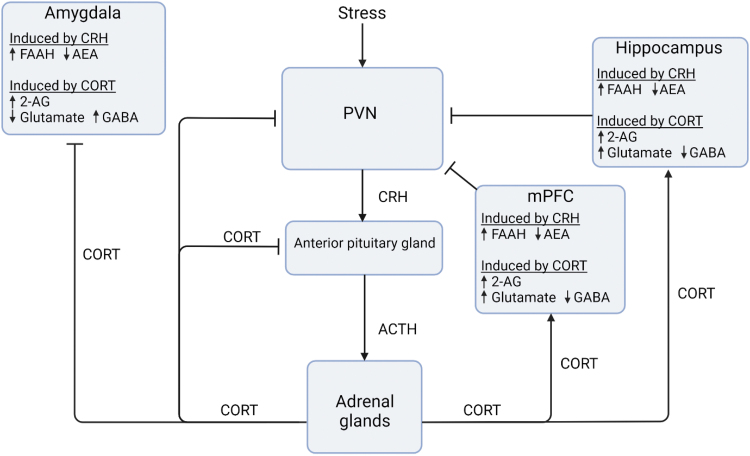FIG. 1.
Endocannabinoid interactions with the HPA axis stress response. In response to stress, the PVN CRH is released, which binds to CRHR1 in the amygdala, hippocampus, mPFC, PVN, and other brain regions. CRH increases FAAH levels in most brain areas, which in turn reduce AEA and remove AEA-mediated inhibition of the HPA axis. CRH is also released to the anterior pituitary gland, which stimulates the release of ACTH into the circulation. ACTH at the adrenal glands induces CORT release into the circulation and provides direct negative feedback to the PVN to reduce production of CRH and ultimately ACTH. CORT also stimulates production of 2-AG in the amygdala, hippocampus, and mPFC, where it binds to CB1 and CB2 receptors on glutamatergic and GABAergic neurons. This inhibits amygdala activation and excites the hippocampus and mPFC activation, reducing HPA axis activity through the level of the PVN. Many of these endocannabinoid systems are disrupted in PTSD. Created with BioRender.com. 2-AG, 2-arachidonoyl glycerol; ACTH, adrenocorticotropic hormone; AEA, anandamide; CB1, cannabinoid type 1; CB2, cannabinoid type 2; CORT, cortisol/corticosterone; CRH, corticotropin-releasing hormone; CRHR1, corticotropin-releasing hormone receptor 1; eCB, endocannabinoid; FAAH, fatty acid amide hydrolase; HPA, hypothalamic–pituitary–adrenal; PFC, prefrontal cortex; PVN, paraventricular nucleus of hypothalamus.

